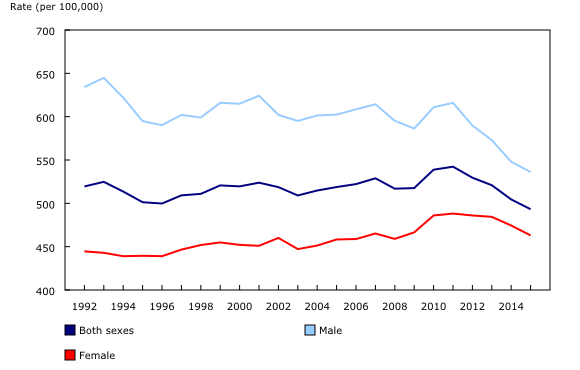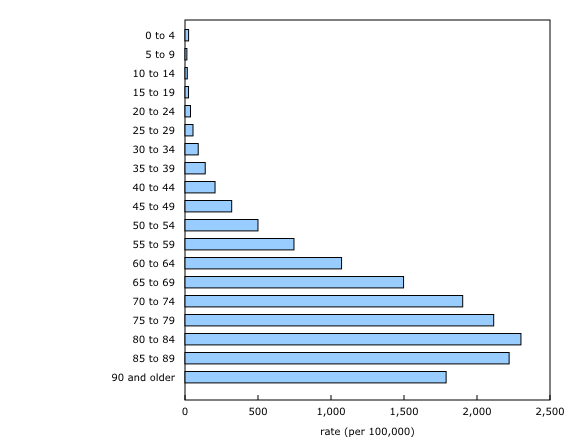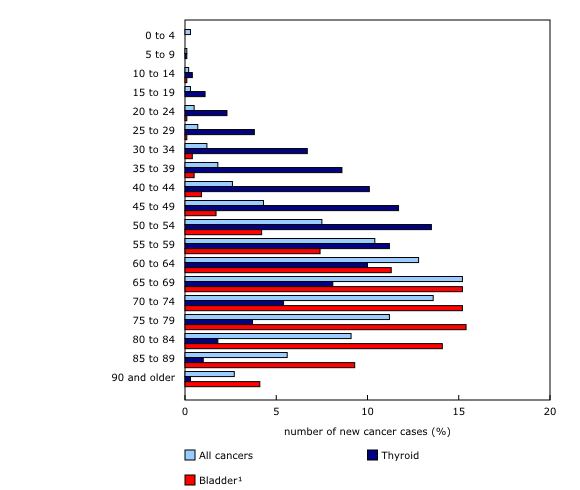Cancer incidence in Canada, 2015
Archived Content
Information identified as archived is provided for reference, research or recordkeeping purposes. It is not subject to the Government of Canada Web Standards and has not been altered or updated since it was archived. Please "contact us" to request a format other than those available.
Released: 2018-01-29
In 2015, more than 141,000 new cases of cancer were diagnosed in Canada, excluding Quebec (see note to readers). The annual number of new cancer cases has been increasing since at least 1992, as the population continues to grow and age.
When taking into account the change in the age distribution of the Canadian population over time, the risk of being diagnosed with cancer (as represented by the age standardized rate) has remained stable over much of the same time period, until a recent decline. This decline is primarily driven by large decreases in the rate of diagnosis of prostate cancer, which has also reduced the gap in cancer incidence rates between the sexes. Recent decreases in prostate cancer are thought to be related to revised screening guidelines for this cancer.
Most common cancers
In 2015, the five most commonly diagnosed cancers (in descending order) for both sexes combined were breast, lung, colorectal, prostate and bladder. However, the five most commonly diagnosed cancers differ by sex. Among males, prostate cancer was the most common (21.4% of new cases among males), followed by colorectal (13.0%), lung (12.3%), bladder (7.5%) and non-Hodgkin lymphoma (5.1%). Among females, breast cancer was most frequently diagnosed (26.6% of new cases among females), followed by lung (12.5%), colorectal (10.6%), uterine (7.0%) and thyroid (5.0%).
The most common cancers by sex have remained stable for over 20 years with the exception of thyroid cancer among females, which replaced non-Hodgkin lymphoma in fifth place in 2005. Increases in thyroid cancer detection are thought to be the result of enhanced diagnostic techniques that have led to the identification of more early-stage, asymptomatic cases.
Cancer by age
Cancer rates generally increase with age. In 2015, age-specific incidence rates for all cancers combined increased with each successive age group, ultimately peaking among those aged 80 to 84.
The age at which cancer is diagnosed, however, can vary markedly depending upon the type of cancer. For example, relative to all cancers combined, thyroid cancer tends to be diagnosed at younger ages, while new cases of bladder cancer are more common in the elderly.
Similarly, the most commonly diagnosed cancers also differ depending on the age group considered. In 2015, testicular cancer was the most common cancer among males under the age of 40, while among females in this age group, it was thyroid cancer. Prostate cancer (males) and breast cancer (females) were the most frequently diagnosed cancers by sex in both the 40 to 69, and 70 and older age groups.
Note to readers
The Canadian Cancer Registry (CCR) is a population based registry that includes data collected and reported to Statistics Canada by each Provincial/Territorial Cancer Registry. The goal of the person-based CCR is to collect information about each new primary cancer diagnosed among Canadian residents since 1992.
Cancer incidence data for Quebec are not available for diagnosis years 2011 and onward. For CANSIM tables 103-0550, 103-0554, 103-0406, and 103-0407, cancer incidence estimates for Canada excluding Quebec were produced for all diagnosis years.
Cancer incidence refers to the number of new cases of cancer in a population over a given period, usually one year. The cancer incidence rate is typically expressed as the number of new cancer cases per 100,000 people.
As the CCR is updated annually with new records and changes to previous records, the incidence for any given diagnosis year may change from one release to the next. In particular, delays in the reporting of new cases to Statistics Canada typically result in undercounts of cases which are more pronounced in the most recently reported diagnosis year. Generally, the reporting delay ranges between 2% and 3% nationally. In addition, death certificate only cases were not reported by Ontario for data years 2014 and 2015, and for Manitoba since 2013 (together totalling about 1,500 cases per year).
Cancer incidence rates are age-standardized using the direct method and the final 2011 Canadian postcensal population structure. Age-standardization allows for comparisons of incidence rates over time that are unaffected by changes in the age distribution of the population. To learn more about this, consult the Age-standardized Rates page of our website.
In October 2014, Ontario implemented a new cancer reporting system, the Ontario Cancer Registry. The new system has several enhancements that permit the identification of cancer cases that previously went unrecorded. These include the use of more liberal rules for counting multiple primary sites, the use of additional source records and the inclusion of records that were previously not included. The implementation of this new system affects data from the 2010 diagnosis year onward.
Products
You can also consult the publication Health Indicators (82-221-X), which has been updated.
Contact information
For more information, or to enquire about the concepts, methods or data quality of this release, contact us (toll-free 1-800-263-1136; 514-283-8300; STATCAN.infostats-infostats.STATCAN@canada.ca) or Media Relations (613-951-4636; STATCAN.mediahotline-ligneinfomedias.STATCAN@canada.ca).
- Date modified:




